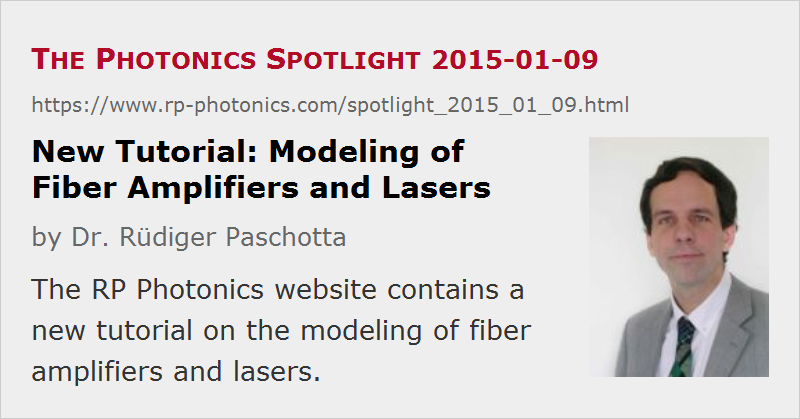New Tutorial: Modeling of Fiber Amplifiers and Lasers
Posted on 2015-01-09 as a part of the Photonics Spotlight (available as e-mail newsletter!)
Permanent link: https://www.rp-photonics.com/spotlight_2015_01_09.html
Author: Dr. Rüdiger Paschotta, RP Photonics Consulting GmbH
Abstract: The RP Photonics website contains a new tutorial on the modeling of fiber amplifiers and lasers.

Ref.: tutorial “Modeling of Fiber Amplifiers and Lasers”
Today, I have published on our website a new tutorial with the title “Modeling of Fiber Amplifiers and Lasers”. Last year, I already published tutorials on passive fiber optics and on fiber amplifiers. In contrast to these, the new tutorial mainly focuses on various aspects of developing and using laser and amplifier models. It is intended to help particularly those who would like to get into this area – either by developing the required software themselves or with commercial software.
I believe that computer modeling will become more and more important in the field of photonics. We still have many development teams and research groups not using such powerful tools, instead relying a lot on trial and error in the laboratory. This is often highly inefficient, however, and this in many ways. One spends time and money for purchasing parts which may not work in the end (e.g. due to wrong design of the setup), and perhaps more importantly spend a lot of time in the lab without making efficient progress. Spent salaries during the wasted time are often only the smaller part of the damage, as there are also infrastructure costs, and lost opportunities in terms of exploiting market potentials or publishing findings in time can even be more damaging than that.
Even if you clearly see in the lab that some setup doesn't work, it is often far from obvious why it doesn't or what you should do to make progress. You then always have to somehow interpret the situation based on some kind of theoretical model – be it a set of vague ideas in your mind or quantitative computer model with which you can really check certain ideas, explanations or possible improvements.
I regularly see people considering whether they can afford to spend a certain amount of money and time for getting into modeling of their devices. Actually, I believe that this is the wrong question. One should determine what is the most efficient way of reaching the central goals, and you cannot afford not to do it in the most efficient way!
Anyway, I hope that this tutorial will help many industry people and researchers to develop clear thoughts on many issues, including both technical and non-technical ones, and thus to make good progress in their jobs. Enjoy the reading!
This article is a posting of the Photonics Spotlight, authored by Dr. Rüdiger Paschotta. You may link to this page and cite it, because its location is permanent. See also the RP Photonics Encyclopedia.
Note that you can also receive the articles in the form of a newsletter or with an RSS feed.
Questions and Comments from Users
Here you can submit questions and comments. As far as they get accepted by the author, they will appear above this paragraph together with the author’s answer. The author will decide on acceptance based on certain criteria. Essentially, the issue must be of sufficiently broad interest.
Please do not enter personal data here; we would otherwise delete it soon. (See also our privacy declaration.) If you wish to receive personal feedback or consultancy from the author, please contact him e.g. via e-mail.
By submitting the information, you give your consent to the potential publication of your inputs on our website according to our rules. (If you later retract your consent, we will delete those inputs.) As your inputs are first reviewed by the author, they may be published with some delay.
 |



If you like this page, please share the link with your friends and colleagues, e.g. via social media:
These sharing buttons are implemented in a privacy-friendly way!